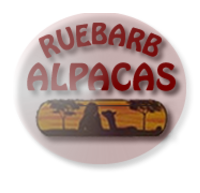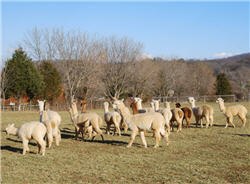Caring for Alpacas
A quick guide to the care and maintenance of alpacas.
Caring for your alpacas is not difficult, but it is important to help keep them fit and healthy and in good condition for breeding. One of the most important monitors of health is the weight of your alpacas. They should not be allowed to gain too much weight as this can lead to fertility and birthing problems. And being too thin can quickly weaken their system and lead to illness or even death.
Observation
It is good to get into a routine of observing your alpacas every day when you feed them - this way you will soon recognize any that are having a problem or not feeling well. Usually they will get over minor problems without any intervention from you, but early warning of more serious issues allows you to take the appropriate action before it escalates.
Body scoring
As well as the regular daily visual check on the herd, a monthly routine should be set up to go over them more thoroughly. This will include giving any worming shots that are needed, applying fly deterrent if necessary, and checking their condition through body scoring.
This is done by feeling along the spine and around the chest and ribs to determine how much weight they are carrying. You can get detailed information on the procedure from any of the alpaca care manuals, but you are basically checking for a thin layer of fat on the chest and ribs, and a tented shape over the spine. If the spine is covered and rounds it is too fat, and if it is too prominent the animal is too thin. A scoring system of 1-5 is usually used, with 1 being emaciated and 5 being obese.
Nails and teeth
The monthly health check is also the time to check the alpacas' teeth and nails. As alpacas only have teeth on the lower jaw, if they are not perfectly aligned, they can grow too large and need to be trimmed back. This is usually done by the vet, or by the shearer when he visits.
Male alpacas also grow fighting teeth. These are six razor sharp teeth, three on each side of the jaw, and they appear when the alpaca is about two years' old. They must be cut off at the gum level to prevent them causing serious injury to other male alpacas. The females sometimes grow these teeth but they are usually not prominent and as the females don't fight as the males so, they do not cause a problem.
Stocking levels
Alpacas must always have the companionship of others of their species. They are herd animals by nature and are happiest in larger groups. The number that can be kept on an area depends on a number of factors including the availability and quality of grass. You can keep up to 8 an acre if the grass is really good, but about 5 or 6 would be a better number. In some areas of the country alpacas are kept in dry lot conditions, but this is not good for them - wandering and grazing are their main activities and provide some exercise and mental stimulation.
Any areas to which the herd has access must be kept free of poisonous plants (horse nettles, etc.) and be clear of debris. They also need somewhere to shelter from the sun, wind and rain. A three-sided shelter is ideal. Barns are unnecessary and are usually too enclosed - this can lead to health problems.
Feeding
Grazing on good quality pasture land is the ideal food source, and every effort should be made to see that the fields are as weed free as possible, and that the grass doesn't contain fescue or rye. Orchard grass is best, but brome can be used as well. Clover should not be present. In addition to the pasture land, alpacas should always have access to quality hay (preferably second cut orchard grass) as well, and fresh water at all times. Although it is a matter of personal choice and the needs of individual animals, supplementary feeds may also be given to late gestation or lactating females. These are not necessary for the males.
Shearing
Most farms do their shearing in May, but depending on the area of the country, some will be earlier and some later. The main point is to get the fleece removed before the weather is too hot, and in time for it to grow back for protection in the winter.
The fleece on Huacaya alpacas grows at the rate of about 4 to 6 inches a year: Suri fiber can grow as much as 6 to 9 inches. Most alpacas shear around 3 to 5 lbs of blanket (first quality) every year, and a further 2 to 5 lbs of second and third quality.
The blankets are used for the most luxurious products while the seconds and thirds are used for coarser items such as socks, blankets and rugs. Most farms hire a professional shearer to shear their herd, although with patience and practice it can be done by the alpaca owner.
Overall, alpacas are the undoubtedly the easiest livestock to look after and anyone with an interest in animals will find it a pleasure to work with them.
LaRue and Barbara Austin breed their alpacas at Ruebarb Alpacas, in Houghton, Allegany County, NY.
It is good to get into a routine of observing your alpacas every day when you feed them - this way you will soon recognize any that are having a problem or not feeling well. Usually they will get over minor problems without any intervention from you, but early warning of more serious issues allows you to take the appropriate action before it escalates.
Body scoring
As well as the regular daily visual check on the herd, a monthly routine should be set up to go over them more thoroughly. This will include giving any worming shots that are needed, applying fly deterrent if necessary, and checking their condition through body scoring.
This is done by feeling along the spine and around the chest and ribs to determine how much weight they are carrying. You can get detailed information on the procedure from any of the alpaca care manuals, but you are basically checking for a thin layer of fat on the chest and ribs, and a tented shape over the spine. If the spine is covered and rounds it is too fat, and if it is too prominent the animal is too thin. A scoring system of 1-5 is usually used, with 1 being emaciated and 5 being obese.
Nails and teeth
The monthly health check is also the time to check the alpacas' teeth and nails. As alpacas only have teeth on the lower jaw, if they are not perfectly aligned, they can grow too large and need to be trimmed back. This is usually done by the vet, or by the shearer when he visits.
Male alpacas also grow fighting teeth. These are six razor sharp teeth, three on each side of the jaw, and they appear when the alpaca is about two years' old. They must be cut off at the gum level to prevent them causing serious injury to other male alpacas. The females sometimes grow these teeth but they are usually not prominent and as the females don't fight as the males so, they do not cause a problem.
Stocking levels
Alpacas must always have the companionship of others of their species. They are herd animals by nature and are happiest in larger groups. The number that can be kept on an area depends on a number of factors including the availability and quality of grass. You can keep up to 8 an acre if the grass is really good, but about 5 or 6 would be a better number. In some areas of the country alpacas are kept in dry lot conditions, but this is not good for them - wandering and grazing are their main activities and provide some exercise and mental stimulation.
Any areas to which the herd has access must be kept free of poisonous plants (horse nettles, etc.) and be clear of debris. They also need somewhere to shelter from the sun, wind and rain. A three-sided shelter is ideal. Barns are unnecessary and are usually too enclosed - this can lead to health problems.
Feeding
Grazing on good quality pasture land is the ideal food source, and every effort should be made to see that the fields are as weed free as possible, and that the grass doesn't contain fescue or rye. Orchard grass is best, but brome can be used as well. Clover should not be present. In addition to the pasture land, alpacas should always have access to quality hay (preferably second cut orchard grass) as well, and fresh water at all times. Although it is a matter of personal choice and the needs of individual animals, supplementary feeds may also be given to late gestation or lactating females. These are not necessary for the males.
Shearing
Most farms do their shearing in May, but depending on the area of the country, some will be earlier and some later. The main point is to get the fleece removed before the weather is too hot, and in time for it to grow back for protection in the winter.
The fleece on Huacaya alpacas grows at the rate of about 4 to 6 inches a year: Suri fiber can grow as much as 6 to 9 inches. Most alpacas shear around 3 to 5 lbs of blanket (first quality) every year, and a further 2 to 5 lbs of second and third quality.
The blankets are used for the most luxurious products while the seconds and thirds are used for coarser items such as socks, blankets and rugs. Most farms hire a professional shearer to shear their herd, although with patience and practice it can be done by the alpaca owner.
Overall, alpacas are the undoubtedly the easiest livestock to look after and anyone with an interest in animals will find it a pleasure to work with them.
LaRue and Barbara Austin breed their alpacas at Ruebarb Alpacas, in Houghton, Allegany County, NY.
July 28, 2017

